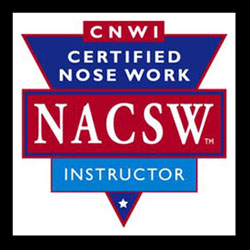Dog skills
- independent searching
- conditioned to hunting for primary or the three target odors
(birch, anise, clove) - ability to search comfortably in a variety of environments
- understanding problem solving
Handler skills
- reading changes of behavior
- ability to articulate them
When You Arrive
Once you have parked leave your dog in your vehicle . The ideal ritual is to use your vehicle to provide the dog a safe, quiet place when off-duty or not searching. Leave plenty of space between vehicles and the entrance/exit areas. Be aware of the teams ahead and after you. We want the dog’s expectation to be when exiting your car they will be ready to work. After your turn you will return to your car. This mimics a trial situation where you are at the site for many hours and will need your dog to be relaxed and ready to search when it is their turn.
Entering and Exiting the Search Area
Ideally search areas will have separate entrances and exits. You will also have a running order. When the dog ahead of you is entering the search, it is a good time to begin the ritual of getting your dog ready. If you need more time to prepare, begin with two dogs ahead of you. Always wait to enter the search area until the dog ahead of you exits.
I structure my classes to be the most secure space possible, both physically and emotionally for the dogs and people. Dogs should never be asked to see another dog while searching.
Fellow Student Courtesy
When another team is searching it is important not to talk or move while observing the other searches. Being respectful to the other teams is also is the best way to learn handler observation skills. If you are returning to the search area from your vehicle always wait until the search has completed.
Reactive Dogs
This term is often misunderstood. It does not specifically mean aggressive and it is not a punitive term. A dog can behave in a reactive manner if it wants to interact in a non-aggressive manner with either dogs or people. It could mean the dog is frustrated, stressed, anxious, fearful, or highly aroused. Reactivity can be displayed on occasion by normally non-reactive dogs so all handlers need to be constantly aware of their own and other dog’s behavior. Being aware will ensure everyone’s safety.
Handlers who know their dogs could exhibit stress, anxiety, or reactivity in a particular situation can use this knowledge effectively by saying, for example, “My dog is comfortable with people at a distance of ten feet.” Giving this information to the instructor and to other classmates will help to keep your dog comfortable and safe. That said, nose work will not fix your dog and you will need to work on your dog’s behavior away from searches and target odor.
Since it can be difficult to predict how dogs will behave, there will be only one dog allowed in the search area at a time. If a dog is overly disruptive you might be asked to sit outside with them or to leave entirely so the class can resume. We can talk about possible solutions and things to work on at home.
Leashes, Harnesses, and Treats
Bring plenty of high-value treats (for example, cheese or meat from the deli) cut into small pieces about the size of your little fingernail. Consider feeding your dog half of their regular meal before class. Other helpful gear is a non-restrictive harness and a 6-10 foot leash.
If you have any questions or concerns, email me at k9@virginiahowe.com

